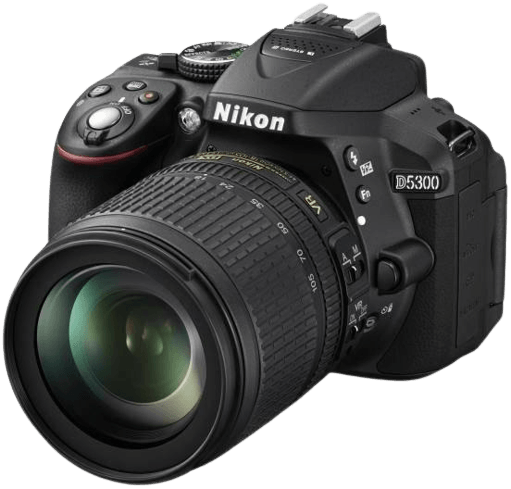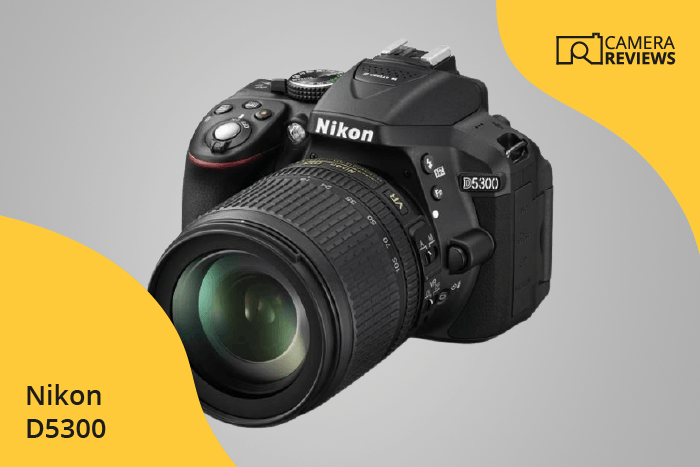Nikon D5300 Specs and Scores

The Nikon D5300, with a score of 57/100, is a DSLR camera announced on October 17, 2013, and released the same year. Priced at $800 during its launch, the camera measures 125 x 98 x 76mm and weighs 480g (1.06lbs). Although the specifications might not be the most advanced in today’s market, the D5300 still offers decent performance for its age and price range. This camera provides a solid option for those seeking a reliable DSLR without breaking the bank.
Nikon D5300 Overview and Optics
The optics of the Nikon D5300 receives a score of 65/100. This camera features 24.2 megapixels, a shooting speed of 5 frames per second, and a CMOS sensor. The Expeed 4 processor contributes to its performance, while the DXOMARK score for the sensor is 83. The sensor size is an APS-C, and the lens mount is a Nikon F DX. However, the camera lacks image stabilization and has an aspect ratio of 3:2.
In the current market, these specifications provide decent performance for amateur photographers and casual users. The 24.2-megapixel resolution ensures high-quality images, and the APS-C sensor size captures a good amount of detail. The Expeed 4 processor facilitates fast image processing, and the Nikon F DX lens mount offers compatibility with a wide range of lenses.
Despite the lack of image stabilization, the Nikon D5300 still delivers respectable image quality and performance. Its specifications make it a suitable camera for individuals seeking reliable performance without the need for advanced features.
Nikon D5300 Video Performance
The Nikon D5300 receives a video score of 70 out of 100. This camera offers Full HD video recording with a maximum resolution of 1920 x 1080 pixels. It supports a top video frame rate of 60 frames per second, allowing for smooth footage capture. Additionally, the D5300 includes built-in time-lapse functionality, providing creative opportunities for users.
When comparing the Nikon D5300’s video capabilities to other cameras in today’s market, it provides a solid performance for its price range. However, it lacks the 4K resolution found in more advanced models. Despite this limitation, the D5300 remains a suitable option for casual videographers or those on a budget who prioritize high-quality Full HD video.
The Nikon D5300 delivers respectable video performance, but may not satisfy users seeking cutting-edge features. Its Full HD resolution and time-lapse capabilities make it a reliable choice for those who prioritize these aspects and do not require 4K video.
Nikon D5300 Features and Benefits
The Nikon D5300 scores 46/100 for its features, reflecting a decent range of capabilities. The camera offers a 3.2-inch screen with a resolution of 1,037,000 dots. However, it does not have a touchscreen. The presence of a flip screen enhances its usability for various shooting angles. Additionally, the D5300 is equipped with GPS and WiFi for easy geotagging and wireless data transfer. The absence of Bluetooth is a limitation in terms of connectivity options.
Comparing these specifications to other cameras in today’s market, the Nikon D5300 holds its ground, but it may not be the most advanced option available. The lack of a touchscreen and Bluetooth may deter some users seeking more modern features. The D5300 remains a reliable choice for those who prioritize GPS and WiFi capabilities, along with a flip screen for versatile shooting.
Nikon D5300 Storage and Battery
The Nikon D5300 receives a storage and battery score of 29/100. This camera has a single memory card slot, accepting SD, SDHC, and SDXC cards. In today’s market, many cameras offer dual card slots, providing versatility and increased storage capacity.
Regarding battery life, the D5300 can capture up to 600 shots with its EN-EL14a battery. This performance is average among modern cameras. However, the D5300 lacks USB charging capabilities, which is a drawback for on-the-go photographers who desire convenience.
The D5300’s storage and battery capabilities are satisfactory but not exceptional. It may suit the needs of casual photographers, but professionals may seek more advanced options.
Nikon D5300 Alternatives
Do you want to know how the Nikon D5300 compares to its competitors? Have a look at the most popular comparisons for this camera below:
- Nikon D5300 vs D5600
- Nikon D3500 vs D5300
- Nikon D5300 vs D7000
- Nikon D5300 vs D5500
- Nikon D3300 vs D5300
- Nikon D3200 vs D5300
Nikon D5300 FAQ
Does the Nikon D5300 Have Built-in Image Stabilization?
No, the Nikon D5300 does not have built-in image stabilization. However, it supports lenses with Vibration Reduction (VR) technology for stable and sharp images.
Does the Nikon D5300 Support 4K Video Recording?
No, the Nikon D5300 does not support 4K video recording. The maximum video resolution it offers is Full HD 1080p at 60 frames per second.
What Size Sensor Does The Nikon D5300 Have?
The Nikon D5300 features a 24.2-megapixel APS-C (23.5 x 15.6 mm) CMOS sensor, providing excellent image quality and low-light performance.
Does the Nikon D5300 Have a Dual Memory Card Slot?
No, the Nikon D5300 has only a single SD/SDHC/SDXC memory card slot, which supports UHS-I cards for faster read and write speeds.
Does the Nikon D5300 Have a Touch Screen?
No, the Nikon D5300 does not have a touch screen. It features a 3.2-inch vari-angle LCD monitor with 1,037k-dot resolution for image preview and settings adjustments.
Does the Nikon D5300 Have Wi-Fi and Bluetooth?
Yes, the Nikon D5300 has built-in Wi-Fi for wireless image transfer and remote control via a compatible smartphone. However, it does not have Bluetooth connectivity.
Does the Nikon D5300 Have GPS?
Yes, the Nikon D5300 includes a built-in GPS feature, allowing users to geotag images with location information and track their shooting locations.
Is the Nikon D5300 Weather Sealed?
No, the Nikon D5300 is not weather sealed, so it’s essential to take precautions when using the camera in harsh weather conditions or dusty environments.
Does the Nikon D5300 Have a Built-in Flash?
Yes, the Nikon D5300 has a built-in pop-up flash, useful for fill flash and low-light situations. It also features a hot shoe for external flash units.

